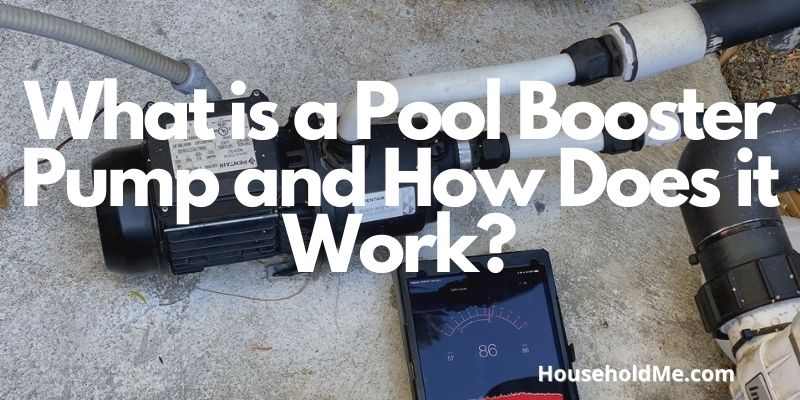If you’re a long-time swimming pool owner, chances are you’ve heard of a booster pump. If you’re new to pool ownership or considering investing in a pressure-side pool cleaner, you’re probably just learning about booster pumps.

Pool Booster Pumps
A booster pump isn’t that much different than the pump already connected to your swimming pool. After you hook up your booster pump, your automatic pool cleaner will receive more water pressure so it can move and function.
Usually, a booster pump has a motor that pushes out 1 horsepower or less. While one of these pumps connects to your swimming pool much like the main pump, a pool booster pump does not come with a strainer basket.
What are the Advantages of using a Booster Pump for your Pool?
As well as making sure you are getting the most from your pool cleaner, adding a booster pump is inexpensive and a simple way to increase the water quality of your pool while lowering its operating costs.
The additional pump can result in improved filtration, faster pool warm-up times, and better chlorine distribution thanks to a more efficient circulation.
A pool booster pump would also give you a choice to increase pressure when needed and to run water features that require more pressure.
What are the parts of a Booster Pump?
It is irrelevant who the manufacturer is as they all share the same basic parts such as:
- The electric motor
- Pump impellers
- An inlet as well as an outlet
- Pressing sensor or a flow sensor
Makers of Pool Booster Pumps
Three manufacturers dominate the pool booster market – Pentair, Hayward, and Polaris/Zodiac. In terms of quality, all three manufacturers are on equal footing.
Often, you’ll notice that manufacturers state in their product descriptions how their booster pumps were made exclusively for their brand of pressure-side pool cleaners.
However, as long as the wiring and plumbing are aligned, you can safely mix brands.
Pressure-Side Pool Cleaners
Before you learn how a booster pump works, you need to know how a pressure-side cleaner functions. Pressure-side swimming pool cleaners are powered by a pool’s return jets, which return water back to the pool after the main pump filters it. These pool cleaners are different from suction-side cleaners, which utilize the water drawn by the skimmer to move.
To use a pressure-side pool cleaner, you must connect the cleaner to a hose, then attach the hose to a water jet. The way the cleaner is constructed allows the water to be sent through the cleaner’s sweeper, which lifts sediment, and the venturi, which suctions coarse particles.
Water expelled by the jet sets the cleaner in motion and the cleaner loosens debris. Large debris are collected by a skimmer bag while fine debris are trapped by the swimming pool’s filtration system.
Water also runs through the pressure-side cleaner’s thrust jet. As you may have guessed by the name, the thrust jet uses the flow of water to propel the cleaner. These cleaners also have a reverse valve that changes and redirects the water, so the cleaner can move in different directions.
How Pool Booster Pumps Work
Many pressure-side pool cleaners require a water pressure of at least 30 PSI (pounds per square inch) in order to function. Before you hook up a booster pump, you have to set up the plumbing.
In most cases, this requires cutting the return pipe and adding a connector, so the water can run through the dedicated cleaner pipe.
As far as electricity goes, you’ll find that the majority of booster pumps are dual-voltage. This means they can run on 230 volts or 115 volts. If you opt for the 115-volt option, you usually have to convert the wiring first.
Booster pumps operate on centrifugal force, using one or multiple impellers to bring in water. As the water is sent through the pump’s impeller and volute, the water pressure increases. Single-stage pumps only have one impeller, dual-stage pumps have two impellers and multi-stage pumps have more than two impellers. The more impellers used, the higher the water pressure.
Related Pool Pump Articles
• Best Pool Pumps
• Best Variable Speed Pool Pumps
• Best Pool Booster Pumps
Info Articles
• 3 Different Kind of Pool Pumps
• What is a Pool Booster Pump?
• What Size Pool Pump Do I Need?
Running a Booster Pump
All booster pumps are different, but there is one usage instruction everyone must follow – only operate the booster pump when the main pump is running and the booster is not self-priming. Otherwise, you risk locking up the booster pump’s motor.
To keep yourself from making this mistake, you can connect an external timer to the booster pump. With a timer, the pool booster pump will start and stop by itself.
Doing this will also help you save on electricity and enjoy a more consistent water pressure even when the swimming pool’s skimmer basket is full.
Keeping your Pool Booster Pump Quiet
Always consider that the pump may vibrate when in operation and the way the pump is installed could worsen the noise if you’re not careful.
Try not to fix the pump straight onto copper supply lines because the vibration might resonate through the copper, and it will sound like a plane going right through your home. Try using a flexible connector on both sides of the pump to avoid any noise it might create.
Troubleshooting
On the off chance that you have a pump and are having issues with it, we’ve made a complete list of possible issues you might be experiencing. If that is the case, call in the services of an authorized professional to diagnose and fix the problem. There are some tests that a handyman could perform to fix simple issues.
Pump not Working
Check if the pump is properly connected to the correct voltage. If it is a 230 Volt pump connected to 115 Volts or the other way around, it probably won’t work and you will likely damage the pump.
Utilize a multimeter to ensure that the power provided does not exceed 10% of the specified voltage on the nameplate.
Also, test the capacitor to see if it is malfunctioning and requires replacement.
Use a 1/4″ hex key on the fan cover and try to turn the driveshaft. If it is difficult to turn, it may be damaged and needs replacing.
Cleaner not Working
- Ensure that all valves are in the correct positions.
- Clean the skimmer basket, pump, and filters.
- Check that all settings are correct as described in the manual.
The pump may not be powerful enough for the amount of pool gear attached to it. Instead of running everything simultaneously, run each component independently. You could also use a higher-powered setting on the pump if it’s able to. Otherwise, buy a stronger pump.
Air Pockets in the Basket of the Filter
If you notice bubbles in the basket attached to the filter, ensure that the pool’s water level is correct so air isn’t being sucked into the pipes.
If the water level is correct, turn off the pump and remove the cover. Check for anything obstructing the O-ring on the lid and seal as this might cause it to suck in air. Give it a good clean and replace the cover and tighten it by hand. The seal should close properly and there should not be any dirt on it.
Check the pipes on the suction side with the pump running and fix it if necessary.
Make sure the connections are all tightened properly and that no air can be sucked into it. You may have to utilize pliers to tighten the connections, but do not over-tighten.
Pressure Fluctuates or Drops
Inspect the pump impeller for signs of wear and tear and replace it if needed.
Ensure that the O-Ring is properly seated and does not show any signs of damage.
Also, ensure that the seal on the pump isn’t damaged and drawing in air. If you can hear air movement, call a professional to tend to it.
If it was recently installed, there might be a problem with the connection. Ensure that the voltage is within 10% of the pump’s rating. If not, get an electrician to have a look.
Leaking Pump
If you notice a leak between the pump body and the motor itself, it could be an indication that the seal is damaged and should be replaced.
Overheating and Switching Off Regularly
Ensure that there is sufficient air ventilation around the pump to keep it cool during operation.
Also ensure that the voltage supplied to the pump is correct.
Noisy Operation
Inspect if there are blockages, leaks, or gunk on the pump or around it. If the pump is noisy when it’s working and you see any of these issues, correct them. Booster pumps have a finite operating lifespan. It’s conceivable that it has run its lifespan and needs to be replaced.
What about a Booster Pump for Home use?
If you need to increase water pressure in your home, one pump can do the job well enough. In some cases, drawing water from a well will require pressurizing the stream to your home.
If a borehole or well is your water source, it may not provide enough water for the home and you will need an additional storage tank. Installing a booster pump will draw and pressurize water into the house.
If the well or borehole can’t supply enough water to satisfy the demand, the idea would be to fill a tank to capacity and then pump the water into the home for use.
Pool Booster Pump Accessories
Booster Pump Covers
A pump cover is the cheapest way to look after your equipment if you live in an environment where you have a lot of rain and/or snow at certain times of the year.
These pumps are meant to work outside and are able to handle all kinds of climate situations, but it is recommended that you consider buying a cover to protect your pump and extend its life cycle. A cover is an easy and inexpensive way to protect the pump if you have nothing else.
The air vents on some pumps cannot withstand rain or other sources of water such as sprinklers.
Pool Shed
If you have a well-ventilated shed with enough space for a pump, it will be a great solution. A shed would be suggested as a first option as it provides year-round protection for your equipment and is inexpensive.
Our Recommended Pool Pumps
Sources:
HouseholdMe: Best Pool Booster Pumps in 2023
Energy: Best Pool Pumps
NREL: Best Variable Speed Pool Pumps
Australian Government: 3 Different Kind of Pool Pumps
If you have any questions or comments, please add them below in the comment section. Similarly, please let us know if you spot any mistakes or omissions. Thanks!
Last Update: 2024-04-16 | Affiliate links/Images from Amazon Product Advertising API






